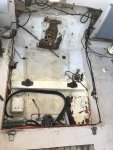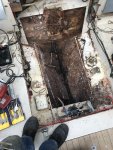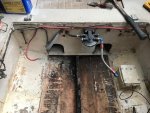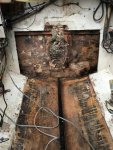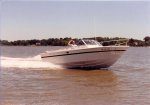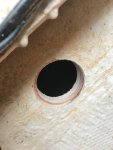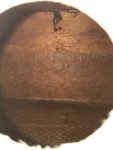Hi all,
I started this adventure with a thread on the Mercruiser repair section, but now I'm doing hull work so I thought I'd get a fresh start. I know there is a lot of information out there regarding transom/stringer repairs and the like, but I have a question about a specific aspect of that. I'm trying to do a "partial" transom rebuild - see the pictures. I've opened up a portion of the transom, and trying to remove material from the areas beyond the opening well enough to stitch in new material without having to gut the whole transom. The transom is in good shape from about the midway point up. But the rot goes all the way to both sides in the lower areas. I think I have a handle on this... I'm intentionally limiting the repair so I don't have to gut the whole cockpit. And, yes there is some rot in the stringers that I'm not going to be able to address. But overall, the stringers are not it that bad a condition, and this is an old boat that seems like it was overbuilt - the glass on the stringers is extremely thick, I'm not too worried about a structural issue there.
The little question I have at the moment is what to do with the area in the engine bay where there was an "inner bottom", which I've removed (see pics). There was a horizontal board fiberglassed in the bottom that created a small "sub-bilge" area below this false bottom. I've removed it up to the bulkhead separating the engine bay from the area forward of that which houses the fuel tank.
My question is, does this inner bottom need to even be replaced? Is there any real structural element provided by this board? Is there some reason I can't leave it open to the hull there? What are the pros and cons of replacing this board?
The first picture is prior to removing it, other photos are after.
I started this adventure with a thread on the Mercruiser repair section, but now I'm doing hull work so I thought I'd get a fresh start. I know there is a lot of information out there regarding transom/stringer repairs and the like, but I have a question about a specific aspect of that. I'm trying to do a "partial" transom rebuild - see the pictures. I've opened up a portion of the transom, and trying to remove material from the areas beyond the opening well enough to stitch in new material without having to gut the whole transom. The transom is in good shape from about the midway point up. But the rot goes all the way to both sides in the lower areas. I think I have a handle on this... I'm intentionally limiting the repair so I don't have to gut the whole cockpit. And, yes there is some rot in the stringers that I'm not going to be able to address. But overall, the stringers are not it that bad a condition, and this is an old boat that seems like it was overbuilt - the glass on the stringers is extremely thick, I'm not too worried about a structural issue there.
The little question I have at the moment is what to do with the area in the engine bay where there was an "inner bottom", which I've removed (see pics). There was a horizontal board fiberglassed in the bottom that created a small "sub-bilge" area below this false bottom. I've removed it up to the bulkhead separating the engine bay from the area forward of that which houses the fuel tank.
My question is, does this inner bottom need to even be replaced? Is there any real structural element provided by this board? Is there some reason I can't leave it open to the hull there? What are the pros and cons of replacing this board?
The first picture is prior to removing it, other photos are after.




















